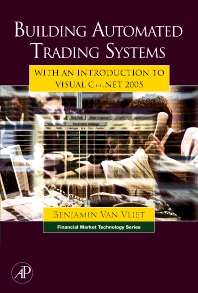LIMITED OFFER
Save 50% on book bundles
Immediately download your ebook while waiting for your print delivery. No promo code is needed.
Over the next few years, the proprietary trading and hedge fund industries will migrate largely to automated trade selection and execution systems. Indeed, this is already ha… Read more

LIMITED OFFER
Immediately download your ebook while waiting for your print delivery. No promo code is needed.
Over the next few years, the proprietary trading and hedge fund industries will migrate largely to automated trade selection and execution systems. Indeed, this is already happening. While several finance books provide C++ code for pricing derivatives and performing numerical calculations, none approaches the topic from a system design perspective. This book will be divided into two sections: programming techniques and automated trading system ( ATS ) technology and teach financial system design and development from the absolute ground up using Microsoft Visual C++.NET 2005. MS Visual C++.NET 2005 has been chosen as the implementation language primarily because most trading firms and large banks have developed and continue to develop their proprietary algorithms in ISO C++ and Visual C++.NET provides the greatest flexibility for incorporating these legacy algorithms into working systems. Furthermore, the .NET Framework and development environment provide the best libraries and tools for rapid development of trading systems.
The first section of the book explains Visual C++.NET 2005 in detail and focuses on the required programming knowledge for automated trading system development, including object oriented design, delegates and events, enumerations, random number generation, timing and timer objects, and data management with STL.NET and .NET collections. Furthermore, since most legacy code and modeling code in the financial markets is done in ISO C++, this book looks in depth at several advanced topics relating to managed/unmanaged/COM memory management and interoperability. Further, this book provides dozens of examples illustrating the use of database connectivity with ADO.NET and an extensive treatment of SQL and FIX and XML/FIXML. Advanced programming topics such as threading, sockets, as well as using C++.NET to connect to Excel are also discussed at length and supported by examples.
The second section of the book explains technological concerns and design concepts for automated trading systems. Specifically, chapters are devoted to handling real-time data feeds, managing orders in the exchange order book, position selection, and risk management. A .dll is included in the book that will emulate connection to a widely used industry API ( Trading Technologies, Inc.’s XTAPI ) and provide ways to test position and order management algorithms. Design patterns are presented for market taking systems based upon technical analysis as well as for market making systems using intermarket spreads. As all of the chapters revolve around computer programming for financial engineering and trading system development, this book will educate traders, financial engineers, quantitative analysts, students of quantitative finance and even experienced programmers on technological issues that revolve around development of financial applications in a Microsoft environment and the construction and implementation of real-time trading systems and tools.
1. Introduction
Section I: Introduction to Visual C++.NET 2005
2. The .NET Framework
3. Tracking References
4. Classes and Objects
5. Reference Types
6. Value Types
7. Unmanaged Objects
8. Composition
9. Properties
10. Structures and Enumerations
11. Inheritance
12. Converting and Casting
13. Operator Overloading
14. Delegates and Events
15. Arrays
16. Generating Random Numbers
17. Time and Timers
18. Input and Output Streams
19. Exception Handling
20. Collections
21. STL/STL.NET
22. DataSets
23. Connecting to Databases
24. Structured Query Language
25. XML
26. Financial Information Exchange Protocol
27. Serialization
28 Windows Services
29 Setup and Installation Packages
Section II: Concurrency
30 Threading
31 Synchronization Classes
32 Sockets
Section III: Interoperability and Connectivity
33 Marshaling
34 Interior and Pinning Pointers
35 Connecting to Managed DLLs
36 Connecting to Componenet Object Model (COM) DLLs with COM Interop
37 Connecting to C++DLLs with Platform Invocation Services
38 Connecting to Excel
39 Connecting to TraderAPI
40 Connecting to XTAPIConnection_Example
Section IV: Automated Trading Systems
41 Building Trading Systems
42 KV Trading System Development Methodology
43 Automated Trading System Classes
44 Single-Threaded, Technical Analysis System
45 Producer/Consumer Design Pattern
46 Multithreaded, Statistical Arbitrage System
BV
Mr. Van Vliet is also the author of "Modeling Financial Markets" with Robert Hendry (2003, McGraw Hill) and "Building Automated Trading Systems"(2007, Academic Press. Additionally, he has published several articles in the areas of finance and technology, and presented his research at several academic and professional conferences.